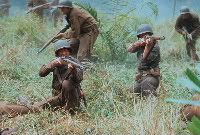Originally written January 12, 1999
Thin Red Line Too Thin
 You seen one war movie, you seen ‘em all. Well, in this case, if you’ve seen one or two great war movies, why do you need to see any more?
You seen one war movie, you seen ‘em all. Well, in this case, if you’ve seen one or two great war movies, why do you need to see any more?
Terrence Malick’s The Thin Red Line isn’t a great war movie, in fact it’s not even a very good one. For all the hype surrounding this recluse director’s first film in twenty years, The Thin Red Line isn’t even the best World War II picture of the year, let alone one of the best overall. I won’t even waste your time to go into any great details about what’s wrong with this film. It’s easy enough to do a bullet-point review (no pun intended) to save all that full paragraph posturing:
– Yes, there are some fine performances, most notably Elias Koteas, Nick Nolte, Sean Penn and newcomer Jim Caviezel, but it’s hard to find any real acting in among all the lingering close-ups. After a while, I found myself only paying attention to how handsome Caviezel is, since all he does is fill the screen with blank looks out into space, supposedly having deep thoughts about something. In fact, Koteas and Nolte are the only ones with any real characters to play, which really makes me wonder why all these Hollywood hot-shots were clamoring to get parts in this film in the first place. Even Penn is relegated to being a third-string bystander who occasionally pops in to utter a profound line. What a waste.
– As for story, don’t even think about it. There are so many little stories trying to be told that not a single one is satisfactory in its telling or conclusion. Don’t get attached to any character because they’ll either disappear entirely, or the film will end with their story unfinished.
– Yes, the film is almost three hours long, and yes, it is way too long.
– Malick added his own thematic touch when he adapted the screenplay from James Jones’ novel. You do have to give him credit for actually giving this film a setting and sense of location. He pays attention to the environment of Guadalcanal, the native people, plants, animals and surroundings. In fact, the only saving grace of this film is the cinematography, courtesy of previous Oscar winner John Toll, who shoots the landscape with sweeping shots and rich close-ups.
– You will be surprised to see all the talent in this film, from John Cusack to Woody Harrelson to Ben Chaplin, to many more up-and-coming young actors in Hollywood. But when John Travolta and George Clooney show up for cameos in this supposedly serious and artistic film, I could only find myself saying “Hey! It’s John Travolta and George Clooney!!” Boy, what a way to hurt your film. (That’s nothing against those two actors, don’t get me wrong, but to take me so out of the environment of the film by placing such familiar superstars in such small momentary roles really can hurt the film, no matter who they are)
– The bottom line is, I’ve seen it all before: the internal monologues, the infighting, the brutalization of the natives, the confusion, the heartlessness, the internal battles, and the external battles. There was nothing new in this film. I saw it all in Platoon, and much better, I may add. Platoon will always be the benchmark for me for war pictures and The Thin Red Line can’t come close.
Saving Private Ryan was at least a new look at an old subject, but The Thin Red Line is just a self-important behemoth that thinks metaphor-telling can replace good old storytelling. So if you want to see everything that The Thin Red Line was trying to be but didn’t succeed, rent Platoon. You’ll save yourself a little money, a lot of time, and experience just a sliver of the horror war can be. However, if you want to experience the horror of sitting through a misguided allegory of a movie, The Thin Red Line is for you.
My rating: ** wait for video
